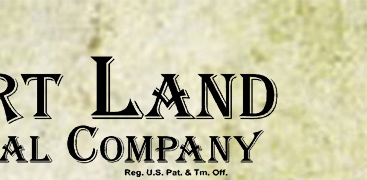History of Southport Land
The Company
On June 15, 1861, eight men, mostly from Martinez, California, sat down to create a corporation for the purpose of mining coal in the foothills of Mount Diablo, 35 miles northeast of San Francisco. They named their company “The Black Diamond Coal Mining Company” (which was later changed) and established corporate headquarters in San Francisco. From these humble beginnings the Company would experience tremendous growth from mining and diversification into other commercial enterprises, including the development of railroads and towns. In its first 50 years the Company survived a surreptitious takeover, a land-grab attempt that would end in a lawsuit being heard before the United States Supreme Court, a disastrous mine explosion, multiple fires, a tragic shipwreck, a patent infringement lawsuit with a second trip to the United States Supreme Court and the Great San Francisco Earthquake of 1906.
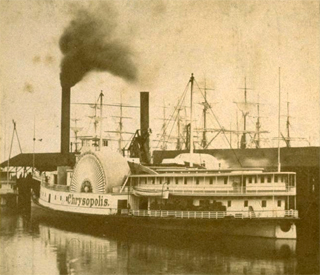 The Chrysopolis. This was the first steamship
The Chrysopolis. This was the first steamshipto successfully burn coal from the Mount
Diablo mines.
Although there was a high demand for coal in the 1860s, there was not much demand for the first coal mined from the Mount Diablo mines. Most coal-burning equipment of that era was designed to burn a different type of coal, which had to be shipped from Washington Territory, British Columbia, England or Australia at great expense. After an engineer on the California Steam Navigation Company’s riverboat Chrysopolis discovered that the Mount Diablo coal would burn well if the fire boxes were modified, the demand for the local coal dramatically increased.
During its early years, the Company prosperously mined coal from its two mines, the Cumberland and the Black Diamond. The town of Nortonville, named in honor of Noah Norton, grew-up in the valley below the mines. Norton had filed the original claim to the Black Diamond Mine in July 1860, but sold his interest in the mine shortly afterwards.
At the mines the coal was sorted by size; the larger-sized was sold as fast as it could be mined and transported. Where the Company fell short was in getting the smaller-sized coal to market. This coal, which was ideal for household and blacksmith use, sold for less. Thus it was uneconomical to transport it by horse and wagon the six miles from the mines to the river for shipping. Without railroad transportation thousands of tons of the smaller-sized coal had to be discarded.
 San Francisco headquarters of the California Steam
San Francisco headquarters of the California SteamNavigation Company. From an 1864 engraving in the Southport Land and Commercial Company Archives.
In late 1865, the Company became the target of a take-over. A group of wealthy capitalists with ties to the Bank of California and the California Steam Navigation Company felt it would be profitable to own coal mines close to San Francisco. However, if word got out that some of the wealthiest men in California were buying stock in a particular company it would send the price of that stock through the roof. In order to prevent this, they supplied the funds for a bank clerk to surreptitiously buy as many shares of Black Diamond stock as possible. Within a month the clerk had amassed more than 85% of the Company’s stock with a par value of $436,500 (over five million dollars at today's value). He then transferred the stock to the capitalists with Alvinza Hayward and Louis McLane owning the largest portions. Hayward, who had made millions in gold mining, was thought to be one of the richest men in California. McLane was the General Manager of Wells Fargo Express and the son of a prominent U. S. statesman. (The others in the take-over group were William Barron, Darius O. Mills, Louis A. Garnett, William C. Ralston, Lloyd Tevis, John M. Bensley and B. M. Hartshorne.)
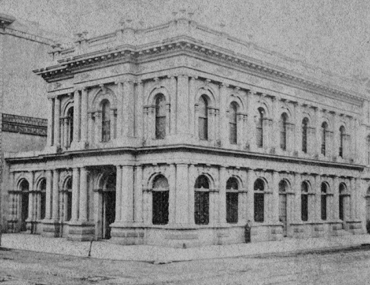 The Bank of California building in San Francisco, circa
The Bank of California building in San Francisco, circa1875. This photograph is attributed to Carleton
Watkins, a famous western photographer. (The Bank
of California is now part of Union Bank.) From a stereoview in the Southport Land and Commercial
Company Archives.
Now owning a controlling percentage of the stock, the group’s first order of business was to attend a special shareholders’ meeting on January 29, 1866, where they were able to fill a majority of the positions on the Board of Directors with members from their group. Having secured control of the Company, they infused it with working capital to further develop and expand the mining operation.
The new Board of Directors wasted no time in making their mark. During the first month of this new management, the Company bought a majority of the stock of the Bellingham Bay Coal Company which operated a mine on Bellingham Bay, Washington Territory. The acquisition of this subsidiary company greatly expanded The Black Diamond Coal Mining Company’s influence in the West Coast coal trade.
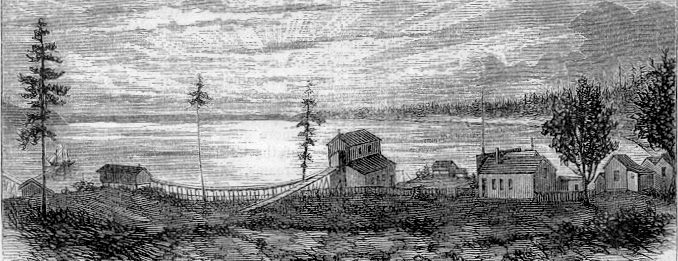
Bellingham Bay Coal Company's mine at Sehome, W.T.
From an 1869 magazine article in the Southport Land and Commercial Company Archives.
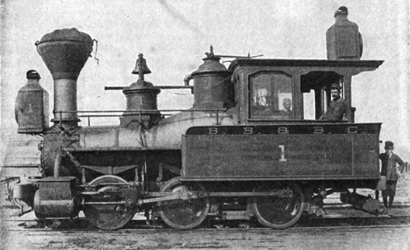 The Black Diamond Coal Mining Company's locomotive
The Black Diamond Coal Mining Company's locomotive"D. O. Mills" as it appeared circa 1897, after being sold
to the Bellingham Bay and British Columbia Railroad. It
was built in 1868 by H. J. Booth & Company's "Union
Iron Works" in San Francisco.
At the same time as the acquisition at Bellingham Bay, the Company had a bill introduced into the California Legislature granting the Company permission to build a railroad from the Company’s coal mines at Nortonville to Black Diamond Landing on the San Joaquin River. The bill passed and the Company brought in John J. Landale, a mining engineer from British Columbia, to survey the new railway. The survey was completed in July, 1866, and work on constructing the railroad commenced soon thereafter, with noted civil engineer Sherman Day in charge. The Company then set its sights on a coal mining opportunity farther north at Comox, British Columbia, leasing a 6,400 acre tract of land from the government and sending Mr. Landale to investigate. However, after one year the venture was abandoned due to the high cost of developing the mine.
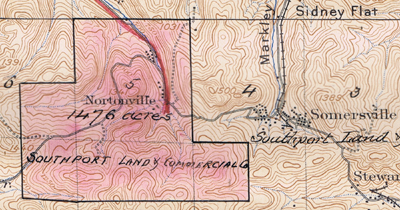
1896 topographic map showing the close proximity of
Nortonville and Somersville. The lands of The Black
Diamond Coal Mining Company are shown in pink. The location of the company's railroad (by then removed) is
shown in red. From the Southport Land and Commercial Company Archives.
Competing coal mining companies were mining at Somersville, one mile due west of Nortonville. Sensing that the Somersville mines could pose a threat to the Company’s mines at Nortonville, a study was commissioned to determine if that threat was real. The study concluded that one of the Somersville mines, the Manhattan Mine, was on the same coal vein as the Company’s mines, which raised a concern because there was no practical way to determine if that mine’s underground workings would eventually, or had already, encroached into the Company's claims at Nortonville. In order to eliminate the threat, the Company bought the Manhattan Mine in October, 1866 and shut it down.
The railroad connecting Nortonville with the river was completed in 1868. With local coal in demand and a railroad to expedite getting it to market, the Cumberland and Black Diamond mines and their environs began to develop. The number of men employed rose from 40 to 315 in less than ten years. With more men employed in the mines the town of Nortonville soon grew to one of the largest communities in Contra Costa County.
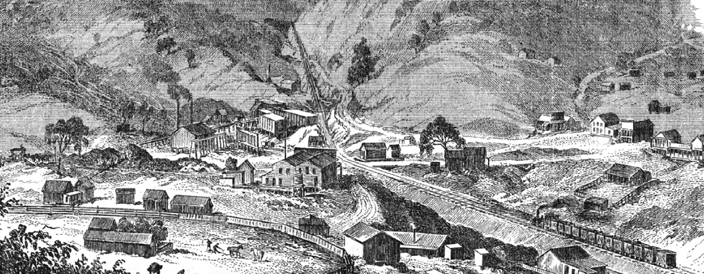
Nortonville, California 1869.
From the Southport Land and Commercial Company Archives.
To see a comparison of the above engraving with a photograph of the same area as it appears
today, click here. For additional engravings of the area, click here.
 Land Office Location No. 261, from August 1865, issued to
Land Office Location No. 261, from August 1865, issued toFrank Barnard, an officer of The Black Diamond Coal Mining
Company. This was the document that began the process of
obtaining title from the State. That process was never completed after the capitalists took over the Company five months later, resulting in litigation that went
all the way to the U.S. Supreme Court.
The same year the railroad was completed to Black Diamond Landing, the Company found itself in a legal battle over a portion of its mining property at Nortonville. The laws at that time provided a procedure for obtaining title to State land—stake a claim, pay a fee, then apply to the State for title. When the capitalists took over the Company the application for title was in the works, however it was never completed. Two unscrupulous attorneys discovered the incomplete paperwork, and without telling the Company about the problem, they headed to the land office and filed papers to obtain title in their own names. They then won a lawsuit in State court to evict the Company. In a tit-for-tat move, the Company decided to argue that the paperwork filed by the State to obtain title from the Federal Government had its own problems. If that were true, it would mean that the State had no title to give to the two attorneys. The Board of Directors used its political clout and sought help from the U.S. Attorney in San Francisco, who filed a lawsuit asserting the new argument, which was eventually upheld in a United States Supreme Court decision.
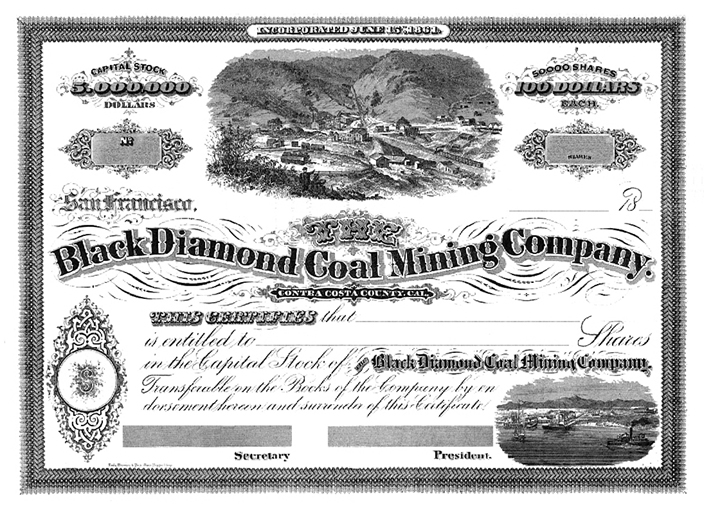
Stock certificate of The Black Diamond Coal Mining Company printed in 1869.
From the Southport Land and Commercial Company Archives.
(For a note on cancelled stock certificates that disappeared from our archives, click here.)
The 1870s were an active decade for the Company. At Nortonville a shaft was sunk to open-up a new area for mining, adding to the Company’s profits. Unfortunately, this would be followed by a series of disasters. The engine-house of the hoisting works over the new shaft was consumed by fire, probably an act of arson. Next a mine explosion killed seven men and injured eight more. The decade ended with a fire destroying 14 buildings in the town of Nortonville.
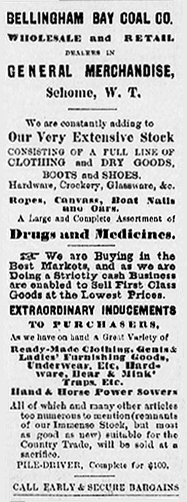
Also during the 1870s a new shaft was dug at the Bellingham Bay mine, but without the same success as Nortonville. The new shaft allowed the mine to be extended under Bellingham Bay; however, there was excessive seepage which flooded the mine’s lower levels, resulting in the closing of the mine in 1878. Despite closing the mine the Company’s subsidiary, the Bellingham Bay Coal Company, continued to operate a general store for several years at Sehome, W.T., selling everything from ladies' underwear to bear traps.
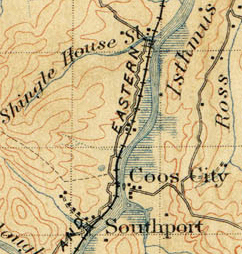
The problems at the Bellingham Bay mine prompted the Company to search for new coal mining opportunities. In the late 1870s the Company acquired two coal bearing properties near present‑day Coos Bay, in southeast Oregon. Exploratory tunnels were dug at the 956‑acre Black Diamond Mine on the peninsula formed by Haynes and North Sloughs, but the mine was never fully developed. In contrast, the 2,636‑acre Southport Mine on Isthmus Slough, across from Coos City, became very prosperous, with the small town of Southport, Oregon growing up in the canyon below the mine. A few years after its initial development, the Company leased the Southport Mine, the mine’s railroad and a nearby wharf to a competing coal mining company.
In 1880 the Company also pursued a new coal mining venture in King County, Washington Territory, southeast of Seattle. Tests proved that this new area contained a higher grade of coal than at Nortonville. It took time to get the mine up and running—title had to be secured and a means of transportation developed. In order to get a railroad built to serve the new mine, the Company loaned $50,000 to the Columbia and Puget Sound Railroad Company for the construction of a 20 mile rail line. The railroad reached the mine in December 1884.
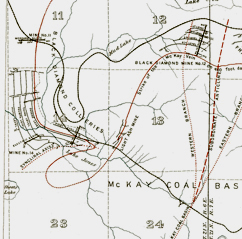 1897 Map of the Company's Coal
1897 Map of the Company's CoalMines at Black Diamond,
Washington. For a larger version
click here. From a U.S.G.S. map in the Southport Land and
Commercial Company Archives.
Many changes occurred during the 1880s. With title and transportation secured in King County, the Company stopped its mining operation at Nortonville in early 1885 and dismantled the railroad which had served the mines. Many of the Company’s employees, along with their families, moved from Nortonville to Washington Territory to work in the new mine thus creating the new town of Black Diamond, W. T.. The Nortonville mines were then leased to others who operated them on a much smaller scale. About the same time, the Bellingham Bay Coal Company sold all of its land at Bellingham Bay and went out of business.
Upon moving out of Nortonville, the Company found itself with tracts of land that were more suitable for development than mining. However, the name, The Black Diamond Coal Mining Company, did not lend itself to the development and sale of real estate. To solve the problem the Board of Directors in 1890 decided to form a wholly owned subsidiary named “Southport Land and Commercial Company” to act as the land development and leasing unit of the mining company. The mining company transferred most of its assets in California and Oregon to the newly formed subsidiary.
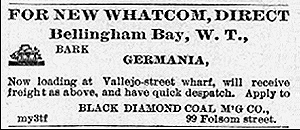
To get its coal to the San Francisco market, The Black Diamond Coal Mining Company also operated a fleet of ocean faring ships and river vessels, including the Germania, Lookout, Amethyst, Columbia, Spartan, Ivanhoe, Edith and Rabboni. Many of these ships operated between Washington and California, taking coal from Seattle to San Francisco, and freight on the return trip. A limited number of passengers were also allowed on each voyage.
In the fall of 1894 disaster struck when the Ivanhoe went missing during a storm on a trip from Seattle to San Francisco. The crew and passengers on board totaled 23 persons; one of the passengers was a prominent Seattle businessman and the former U. S. Ambassador to Bolivia.

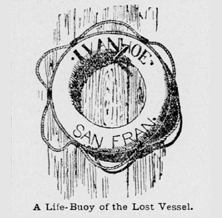
vessels named "Ivanhoe" plying the Pacific waters in the 1890s,
the flags spell out the signal letters of the Ivanhoe that was,
according to official Treasury Department documents, managed by
A. W. Rose, Jr., a Black Diamond Coal Mining Company executive. Above painting from a postcard in the Southport Land and
Commercial Company Archives.
Two months later, a wooden sign with “IVANHOE” in gold letters was found on a beach at Willapa Bay, Washington, and positively identified as having come from the missing ship. Also, a life-buoy from the ship was discovered hanging on the wall of a fisherman’s cabin on an island in Barkley Sound, British Columbia; the cabin’s owner had found it on the beach. The sign and buoy were carefully preserved and sent to Washington Governor John H. McGraw. As one contemporary newspaper account stated, they “will be kept as a sad memento, the two silent witnesses of an irreparable loss.” The sign and bouy were the final evidence to establish the fact that the ship went down and all persons aboard the Ivanhoe had lost their lives.
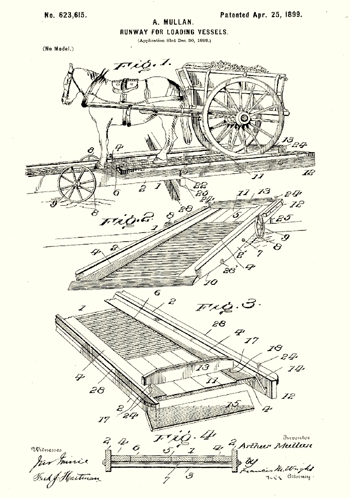 The 1899 patent for a new type of runway to load
The 1899 patent for a new type of runway to loadcoal onto ships. The inventor, Arthur Mullan,
assigned the patent to his employer, The Black
Diamond Coal Mining Company.
To make it easier to load wagons with coal from ships docked at the wharf in San Francisco, the Company began using a portable coal chute. A rival coal company, which held a patent on a similar coal chute, sued The Black Diamond Coal Mining Company for patent infringement. At the end of the trial the rival company was awarded damages, which the Company appealed. In 1895 The Black Diamond Coal Mining Company found itself, for the second time in less than ten years, before the United States Supreme Court arguing a case. In March of that year the Supreme Court issued a decision overturning the damage award on the basis that the coal chute used by the Company was significantly different from the chute described in its rival's patent. That decision continues to be cited as precedent in modern-day patent infringement cases. Having learned the hard way about patents, when an employee of the Company devised a new type of ramp that allowed ships to be loaded with coal directly by horse-drawn wagons, the Company applied for, and received, its own patent on the invention.
Also during the 1890s, The Black Diamond Coal Mining Company became closely associated with, and helped finance, the Mutual Electric Light Company in San Francisco, which was a large consumer of the Company’s coal. Mutual Electric later became part of the Pacific Gas and Electric Company.
With the arrival of the new century the Company came to the realization that demand for its particular type of coal was declining and something had to be done. At a meeting held on January 25, 1902 President Pierre B. Cornwall told the Board of Directors that the Company’s customers were “changing from the use of [the Company’s] coal to oil and other kinds of coal.” This revelation prompted the Company to put its mine in King County, Washington, up for sale and look towards new ventures.
In 1904, two major events happened in the history of The Black Diamond Coal Mining Company. First, the Company’s driving force, its Chairman and largest stockholder, Alvinza Hayward, died. Second, the Company found a buyer for its coal mine at Black Diamond, Washington, thus taking it out of the coal producing business.
The next year, Southport Land and Commercial Company began to develop the town of Black Diamond, California (now part of the City of Pittsburg). It subdivided what is now downtown Pittsburg into city lots. Some lots were sold and some were retained for later development.
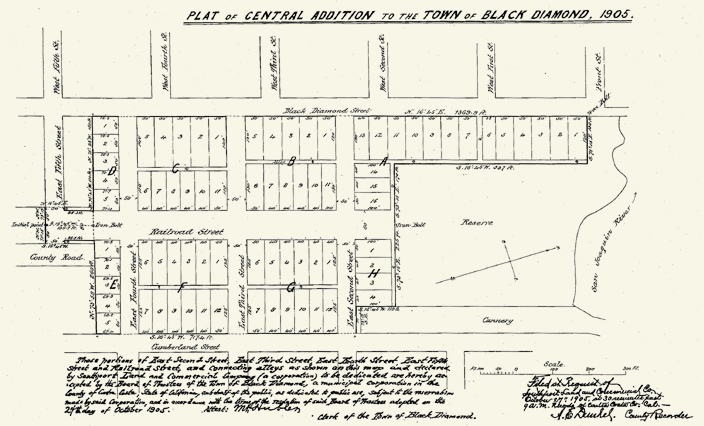
Plat of Southport Land's 1905 addition to the Town of Black Diamond, California (now part of the City of
Pittsburg). The area subdivided by this map is now known as the "Old Town District" of Pittsburg. The
"County Road" shown at the upper left of Block "E" (now Railroad Avenue) did not line up with the
subdivision's Railroad Street, creating a jog which still exists today. For a larger version of this map,
and other historic maps of the area, click here.
Disaster struck the Company's corporate office, located on the second floor of the Mills Building in San Francisco, soon after the Great Earthquake of 1906 shook the city. The building was owned by D. O. Mills, who at the time held the second largest number of shares in the Company. Although one of the tallest buildings in San Francisco, the Mills Building survived the earthquake due to the fact that it was one of the few steel frame buildings in the city. Fortunately, someone had the foresight to remove the Company's important records before fire engulfed that part of the city some forty hours after the earthquake. The building was heavily damaged by the fire and all of its contents destroyed. After the fire, the Company moved to Octavia Street, and later to the town of Millbrae. The Company returned its corporate office to San Francisco a few years later after the Mills Building was rebuilt.
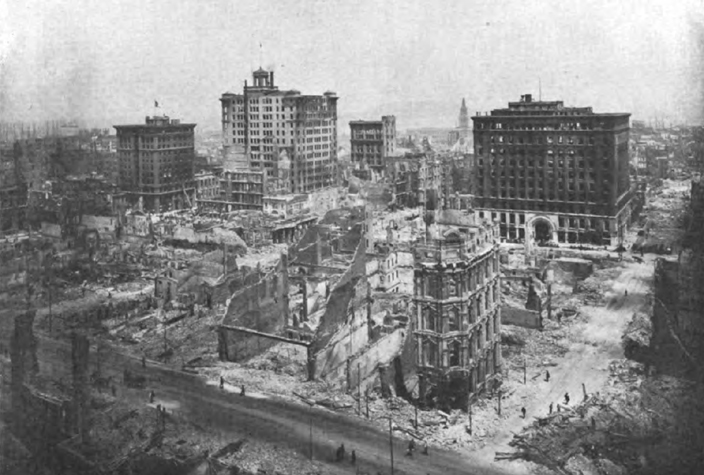
San Francisco after the Great Earthquake and Fire of 1906. The Mills Building, in which
the Company's office was located, is the darker building on the right.
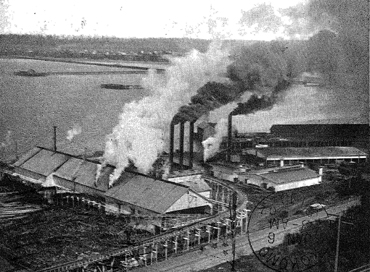 1906 postcard of Bellingham Bay Lumber Company's
1906 postcard of Bellingham Bay Lumber Company'smill on Bellingham Bay, Washington. From the
Southport Land and Commercial Company Archives.
In 1907 the Bellingham Bay Lumber Company was acquired from the Bellingham Bay Improvement Company, launching The Black Diamond Coal Mining Company into new ventures—lumbering and manufacturing. The lumber company owned and operated one of the largest sawmills in the world, with the capacity to produce 375,000 feet of lumber every ten hours. A fifty percent interest in the Bay City Sash and Door Company, a manufacturing enterprise, came with the purchase of the lumber company. These entities were operated as subsidiaries of the mining company until they were sold in 1912 to the Bellingham Securities Syndicate. From 1912 onward, The Black Diamond Coal Mining Company focused its efforts on managing the activities of its remaining subsidiary, Southport Land and Commercial Company.
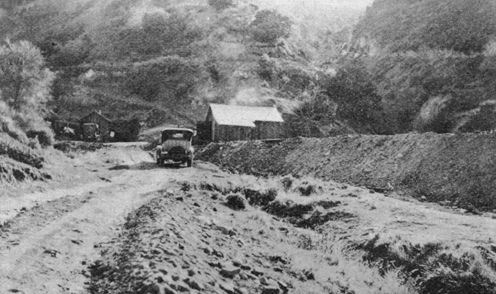 The Black Diamond Mine at Nortonville, circa 1927, when portions of the
The Black Diamond Mine at Nortonville, circa 1927, when portions of theold coal mine were being re-opened as a foundry sand mine. The
canyon visible at the upper right of the photo is the same canyon where
the tramway was located in the late 1860s.
By 1925 the demand for lower grade coal had diminished, so Southport Land ceased leasing the Nortonville mines for coal mining, and began leasing them for the mining of foundry sand and clay. The clay mining was intermittent, but sand mining continued until September 1949 when the mine was shut down because of the closing of the steel casting plant at Columbia Steel Company in nearby Pittsburg. That plant had been the primary customer of the mine. The Nortonville property was again leased for foundry sand mining during the late 1950s through the early 1960s, but this time sand was mined from an open pit. The land was also leased for cattle grazing. With the threat of a nuclear attack during the Cold War of the early 1960s, the underground tunnels of the Nortonville and Somersville mines were studied as possible fallout shelters, however nothing ever was built.
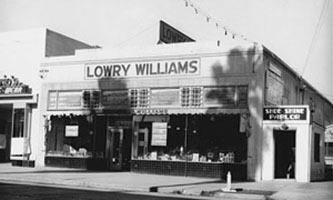
Meanwhile in the 1930s and 40s Southport Land found itself paying increasingly higher taxes on its vacant land holdings in the City of Pittsburg. To off-set this expense, it was decided to increase revenues by embarking on a program of erecting buildings and leasing them. The development projects included the building of two grocery stores, Safeway (later to become Lowry Williams) and Hagstrom’s.
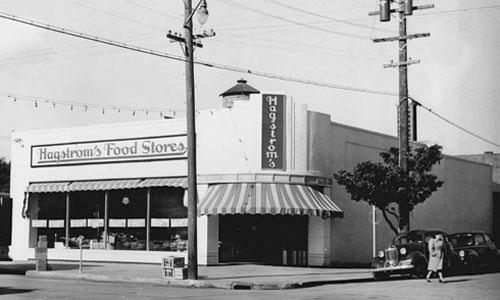
Southport Land and Commercial Company also constructed buildings for smaller tenants, including a bakery and a strip center occupied by five independent clothing and shoe shops.
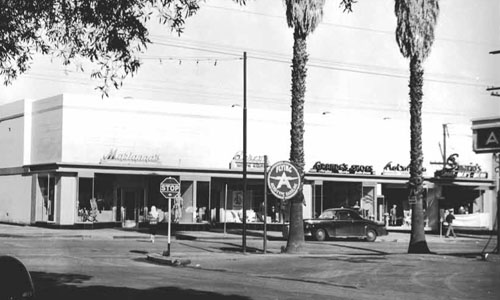
Five store strip center at the northwest corner of Railroad Avenue and
East Sixth Street, Pittsburg. Hagstrom's was located to the left, across
East Sixth Street and out of view. Above three photos from the
Southport Land and Commercial Company Archives.
In addition to building and leasing commercial properties, Southport Land also leased single family residences and apartment buildings in downtown Pittsburg.
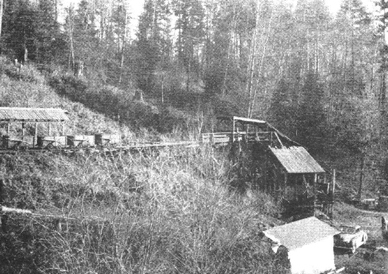
The Southport Mine near Coos Bay, Oregon, circa 1940.
After having been leased for seven decades, the Company sold the Southport Mine in Oregon in 1953, thus severing its last remaining tie to the coal mining industry. In 1959, the Board of Directors of The Black Diamond Coal Mining Company merged its subsidiary, Southport Land and Commercial Company, into the mining company. As part of the merger, the name of the corporation was changed from “The Black Diamond Coal Mining Company” to “Southport Land and Commercial Company.”
During the same year the Company built the first modern supermarket in Pittsburg, California for Lucky Stores, Inc. In the ensuing decades the Company continued to grow by acquiring additional properties throughout Northern California and leasing them to commercial tenants.
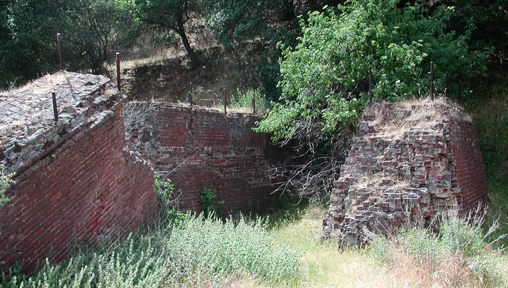
Brick foundation of the hoisting works at the Black Diamond Mine in the
Black Diamond Mines Regional Preserve. This is the only structure that
remains at Nortonville. The foundation at the left of the photo has cracked
in half, and sank into the loose soil where the shaft once was. From the
Southport Land and Commercial Company Archives.
In 1974 Southport Land sold 160 acres of its Nortonville holdings to the East Bay Regional Park District to become part of a park dedicated to the preservation of natural and historic resources in the area. The park was expanded in the 1980s when Southport Land donated 146 acres and sold another 30 acres to the Park District. Today Nortonville, Somersville and the surrounding area are part of the Black Diamond Mines Regional Preserve.
On July 1, 2007, after 146 years of being located in or close to San Francisco, the Company followed the roots of its founders and moved its corporate office to Martinez, California. Today Southport Land and Commercial Company still operates under its original 1861 Certificate of Incorporation (with a few amendments over the years). It is California’s oldest stock corporation still in existence, and overall is California’s fourth oldest corporation of any type. Other existing California corporations can trace their history to before 1861; however, the dates of incorporation of their current corporate existence are much later. In this regard, an interesting resource is a list of California's oldest corporations that still operate under their original incorporation documents.
For links to other websites that have historical information relating to the Company, please see the “History-related Links” section of our Links and Resources page.
![]()
The People
Over the years, many people of historic importance have been associated with the Company as directors, officers and/or major stockholders. These include: Alvinza Hayward, D. O. Mills, William C. Ralston, Pierre B. Cornwall and Heber Reginald Bishop (19th century capitalists), Louis McLane (a President of Wells Fargo), William Sharon (a United States Senator), François L. A. Pioche (a 19th century banker and financier), Lester Ludyah Robinson (19th century railroad builder), Lewis C. Wittenmyer (a long-time County Clerk of Contra Costa County), Dr. Charles McCormick (prominent 19th century Army surgeon), Louis A. Garnett (a 19th century monetary expert), Lloyd Tevis (a Director and President of Wells Fargo), James B. A. Haggin (a Director of Wells Fargo), Frank G. Drum (a Director and President of Pacific Gas and Electric Company), John S. Drum (a Director and Vice-President of Pacific Gas and Electric Company), Garrett W. McEnerney (a Director of Pacific Gas and Electric Company), William J. Dingee (a President of Oakland Water Company, predecessor to East Bay Municipal Utility District), Ogden L. Mills (a United States Secretary of the Treasury), Leslie H. Moore (a President of the Virginia and Truckee Railroad), Duncan A. McLeod (a Director of the Virginia and Truckee Railroad) and William H. Knowles (a prominent San Francisco architect). |
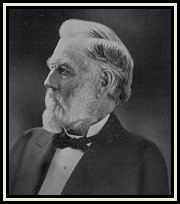 Alvinza Hayward President 1867 to 1872 Director 1866 to 1874 and 1883 to 1904 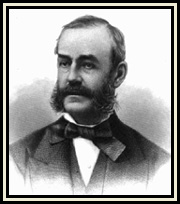 Louis McLane Director 1876 to 1883 |
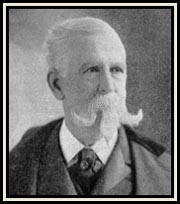 Louis Anacharsis Garnett President 1866 to 1867 Director 1866 to 1870 |
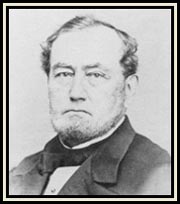 Dr. Charles McCormick One of the original eight founders. Director 1861 |
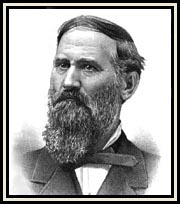 Lewis Cass Wittenmyer One of the original eight founders. Director 1861 to 1863 |
|---|
For a complete |
For a list of company directors from |
|---|
![]()
The Southport Land Corporate Archives
.jpg)
Southport Land and Commercial Company has a collection of historical documents dating back to 1861 in its corporate archives. Most documents post-date 1906 due to the great San Francisco earthquake and fire of that year. To see a PDF image and partial transcript of the minutes of the Company's first meeting from 1861, click here.
The Company is in the process of creating a website, blackdiamondcoal.com, to make more of these historic documents available to the general public. Please periodically view that website to check on its progress.
There are also other archives that contain historical papers related to Southport Land, including:
• The Library of Congress (Reid Family Papers, Box II: 29);
• The Mandeville Special Collections Library, Geisel Library, University of California, San Diego (Ed Fletcher Papers, Box 64, Folder 11);
• The California Historical Society (California Ephemera Collection); and
• The
Schellens Collection of the San Mateo County Genealogical Society, housed in the Redwood City Public Library History Room, (Volume 129, Page 42 and Volume 180, Page 104).
![]()
Printer Friendly Version of this Web Page
Although our “History of Southport Land” web page may display properly in a browser, most browsers lack the ability to properly convert a web page so it can be printed. For those who would like to print this web page, we have provided a printer friendly version in PDF format. Just click the image to the left or the link below. (Please note that it is a large file and may take a few minutes to download.)
LINK:
PDF Version of “History of Southport Land” web page.

